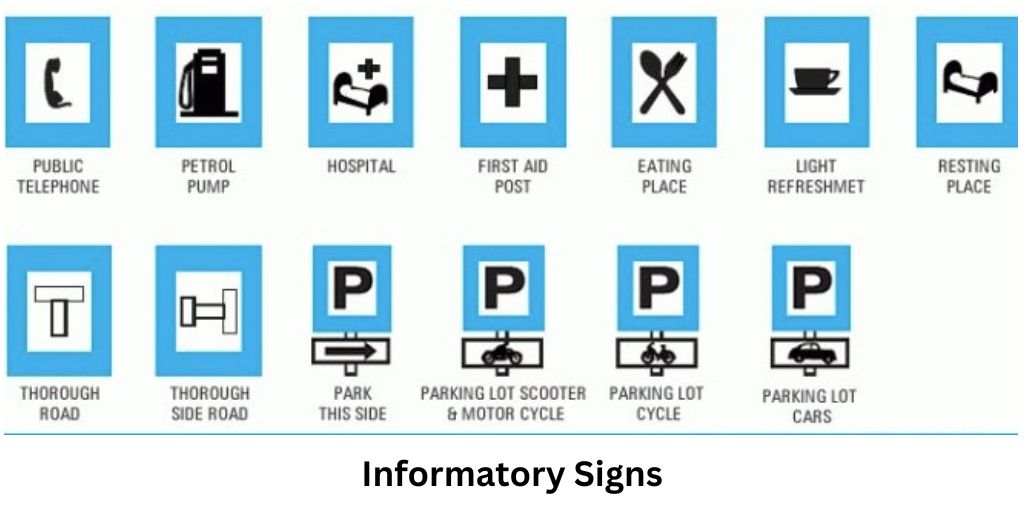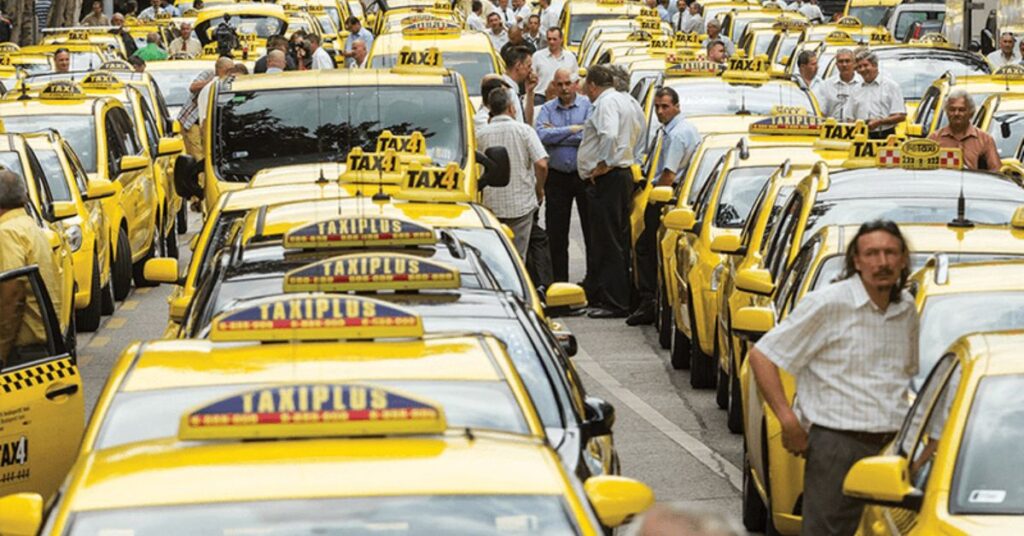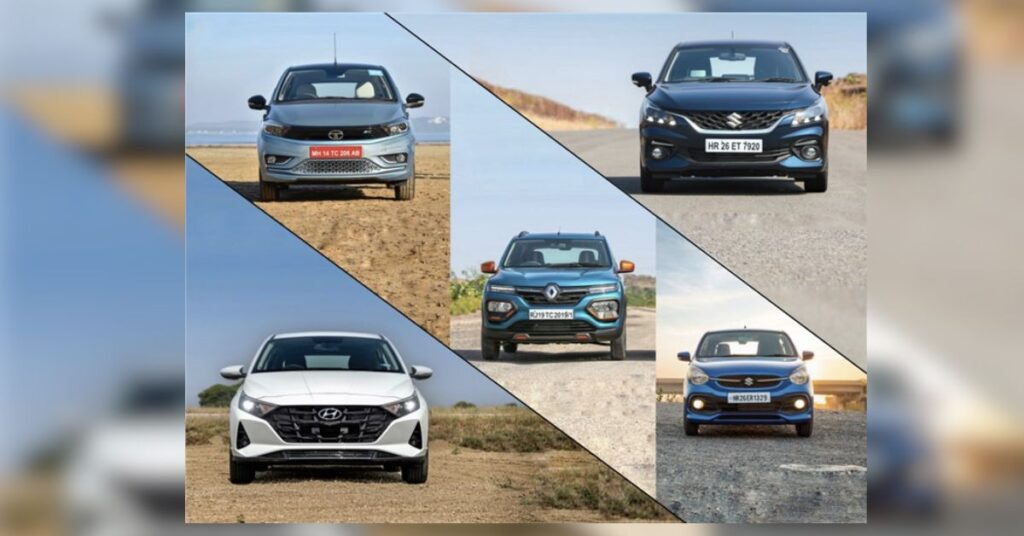Welcome to the world of traffic signs in India, the unsung heroes of road safety! Whether you’re a driver, pedestrian, or cyclist, understanding the meaning of these signs is crucial for your safety and the safety of others on the road.
Traffic signs are more than just symbols and colors. They are designed to be simple and easily understood, regardless of language or literacy. The shapes of traffic signs convey important messages even from a distance, making them an essential part of transportation signs.
If you’re planning to take the driving license test, it’s vital to have a comprehensive understanding of all driving signs. It’s not just about passing a test; it’s about road safety. Learning the language of the road, which includes traffic symbols with names, is like mastering the building blocks of this language.
From the familiar stop sign to the lesser-known “slippery when wet” sign, there are countless road safety signs with names and meanings that every road user should know. In this post, we will cover various road signs, their symbols representing road safety rules, and provide the names associated with these road safety signs.
By familiarizing yourself with these signs, you’ll enhance your ability to navigate the roads safely and effectively. Remember, road safety is a shared responsibility, and understanding and obeying traffic signs play a crucial role in preventing accidents and ensuring a smooth flow of traffic.
So let’s delve into the world of traffic signs and equip ourselves with the knowledge necessary to create safer road environments for everyone.
Types of Traffic Signs
Traffic signs in India can be categorized into three types: mandatory signs, cautionary signs, and informatory signs. Mandatory signs convey obligatory instructions or prohibitions to road users. Cautionary signs indicate potential hazards or dangers on the road. Informatory signs provide information about specific destinations, directions, and distances. Understanding these signs is crucial for ensuring road safety. Let’s explore each type of sign in detail to understand their meanings and how to respond when we come across them while driving.
1. Mandatory Signs
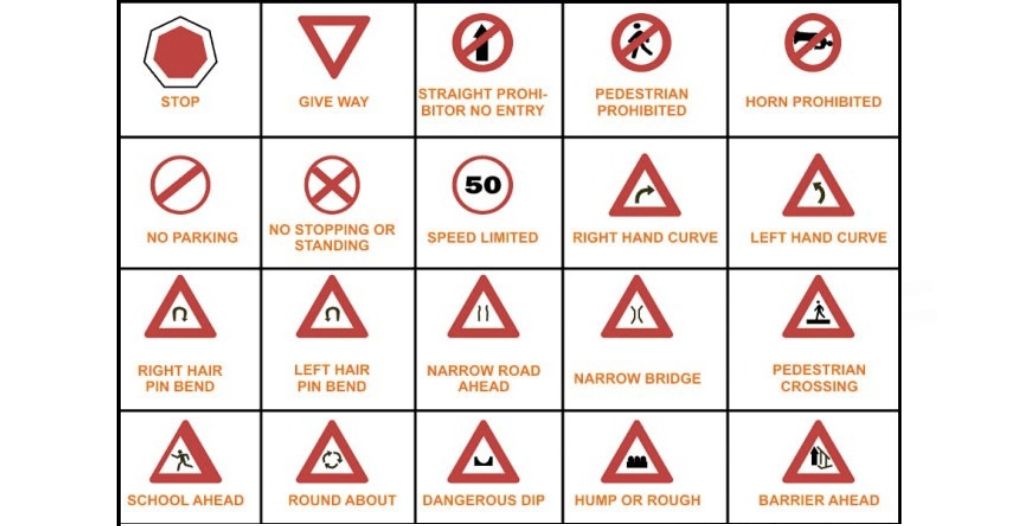
1. Stop: A red octagonal sign that requires drivers to immediately halt their vehicles to avoid accidents.
2. Give Way: An instruction for drivers to yield to oncoming traffic from the right, ensuring smooth flow and preventing collisions.
3. No Entry (Straight Prohibitor): Indicates a restricted area where drivers are prohibited from entering to comply with legal regulations.
4. Pedestrian Prohibited: Signifies that pedestrians are not allowed to walk in that particular area and must choose alternative routes for their safety.
5. No Horn (Horn Prohibited): Prohibits honking in designated areas, creating a peaceful environment for residents and pedestrians.
6. No Parking: Restricts the parking of vehicles in specified areas to maintain smooth traffic flow and prevent congestion.
7. No Stopping or Standing: Instructs drivers not to park or stop their vehicles at the marked location, ensuring continuous traffic movement.
8. Speed Limit: Indicates the maximum speed allowed in a specific area, and drivers must adhere to it to prevent accidents.
9. Right/Left Hand Curve: Warns drivers of upcoming right or left-hand curves, prompting them to drive carefully, reduce speed, and ensure safety.
10. Right/Left Hairpin Bend: Alerts drivers to sharp turns ahead and requires them to slow down to navigate the bend safely.
11. Narrow Road Ahead: Notifies drivers of an upcoming narrow road and encourages cautious driving to avoid collisions.
12. Narrow Bridge: Indicates the presence of a narrow bridge ahead, requiring drivers to be cautious while crossing it.
13. Pedestrian Crossing: Alerts drivers to a designated area where pedestrians may cross, prompting them to slow down and prioritize pedestrian safety.
14. School Ahead: Informs drivers of a nearby school, urging them to reduce speed and take precautions to prevent accidents.
15. Roundabout: Warns drivers of a circular intersection and instructs them to follow the roundabout rules while driving.
16. Dangerous Dip: Indicates a sharp dip or depression in the road ahead, urging drivers to slow down to avoid accidents.
17. Hump or Rough Road: Warns drivers of speed breakers or uneven road surfaces ahead, prompting them to reduce speed for safety.
18. Barrier Ahead: Alerts drivers to the presence of a barrier or toll booth ahead, allowing them to prepare accordingly for the upcoming obstacle.
2. Cautionary Signs
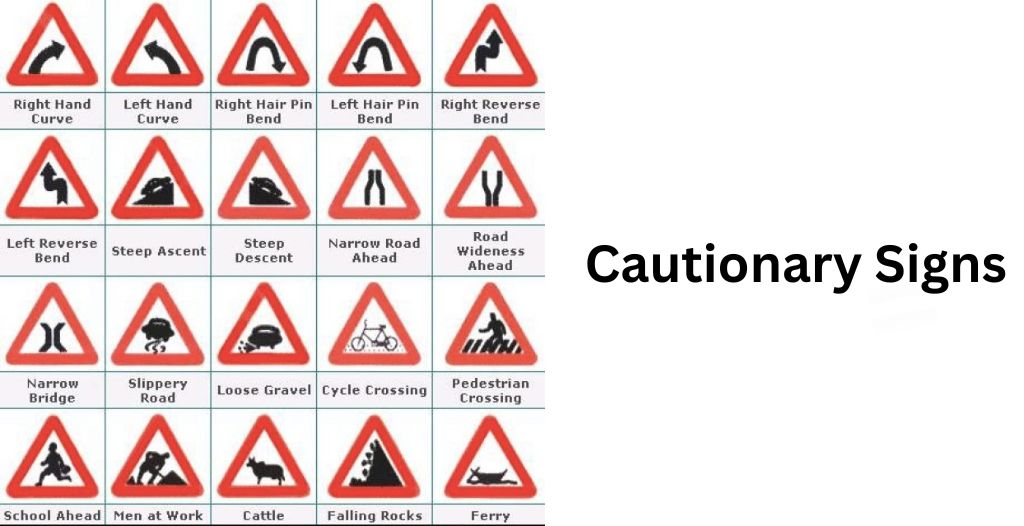
1. Right-Hand Curve: This sign warns drivers about an upcoming right-hand curve on the road. It is crucial to slow down the vehicle and approach the curve with caution.
2. Left-Hand Curve: Similar to the right-hand curve sign, the left-hand curve sign warns drivers about an upcoming left-hand curve on the road.
3. Right Hair Pin Bend: This sign indicates a sharp right turn ahead. The driver should approach such turns slowly to avoid any accidents.
4. Left Hair Pin Bend: This sign indicates a sharp left turn ahead. It is essential to slow down the vehicle and approach such turns with caution.
5. Right Reverse Bend: This sign warns drivers about an upcoming zigzag turn to the right. Drivers should proceed with caution and maintain a safe distance from other vehicles.
6. Left Reverse Bend: Similar to the right reverse bend sign, the left reverse bend sign warns drivers about an upcoming zigzag turn to the left.
7. Steep Ascent: This sign warns drivers that there is a steep upward slope ahead. It is essential to slow down the vehicle and gear appropriately to avoid engine overload and brake failure.
8. Steep Descent: This sign warns drivers that there is a steep downward slope ahead. Drivers should use the engine brake and avoid speeding down the slope.
9. Narrow Road Ahead: This sign warns drivers that the road ahead merges into a narrow lane. Drivers should slow down and give way to oncoming traffic.
10. Road Wideness Ahead: This sign indicates that the road ahead will widen. Drivers can carefully speed up and overtake other vehicles if it is safe to do so.
11. Narrow Bridge: This sign warns drivers about a narrow bridge ahead. Drivers should slow down and cross the bridge cautiously.
12. Slippery Road: This sign indicates that gravel or loose earth keeps falling on the road, making it slippery. Drivers should slow down and drive with caution to avoid skidding.
13. Cycle Crossing: This sign indicates that the road is meant for riding bicycles. Drivers should slow down and give way to cyclists.
14. Pedestrian Crossing: This sign indicates that pedestrians should cross the road. Drivers should slow down and give way to pedestrians.
15. School Ahead: This sign warns drivers about a school nearby. Drivers should slow down and drive cautiously in such areas.
16. Men At Work: This sign indicates that laborers are working on the road ahead. Drivers should slow down and follow the instructions of the traffic personnel.
17. Cattle: This sign warns drivers about the possibility of cattle on the road. Drivers should slow down and drive with care, giving way to cattle.
18. Falling Rocks: This sign warns drivers that the road ahead is prone to falling rocks. Drivers should slow down and drive cautiously to avoid accidents.
3. Informatory Signs
1. Public Telephone: Indicates the presence of a nearby public telephone for emergency phone calls.
2. Petrol Pump: Guides you to the nearest petrol pump when your fuel is running low.
3. Hospital: Indicates the presence of a hospital nearby for medical emergencies.
4. First Aid Post: Points to a nearby first aid facility for basic medical attention.
5. Eating Place: Guides you to the nearest eating place, such as restaurants or cafes, when you’re feeling hungry.
6. Light Refreshment: Indicates the presence of a facility offering light refreshments, where you can grab a quick bite or drink.
7. Resting Place: Indicates the presence of a resting place where you can take a break from driving and relax.
8. No Thorough Road: Indicates that the road does not provide an exit, suggesting you turn back or take an alternative route.
9. No Thorough Side Road: Indicates that there is no through road on the side road, advising you to avoid taking that route.
10. Park This Side: Indicates where you should park your vehicle, eliminating the need to search for a suitable spot.
11. Parking Lot Scooter and Motorcycle: Designates a parking lot specifically for scooters and motorcycles.
12. Parking Lot Cycle: Designates a parking lot specifically for bicycles.
13. Parking Lot Cars: Designates a parking lot specifically for cars.
These informatory traffic signs serve to enhance your journey by providing useful information and guidance.
Traffic Signs For Kids/Students
1. STOP Sign: A red octagonal-shaped sign that commands drivers to come to a complete stop. It is crucial for children to understand that whenever they encounter this sign, they must follow a specific procedure: look left, right, and left again before crossing the road.
2. School Crossing Sign: A yellow-green diamond-shaped sign that serves as a warning that a school is nearby and children might be crossing the road. Children should exercise extra caution and remain vigilant for approaching vehicles.
3. Slow: Children At Play Sign: This yellow diamond-shaped sign portrays a child, alerting drivers that there might be children playing in the area. It is a clear indication for drivers to reduce their speed and be mindful of the surroundings.
4. Seat Belt – Buckle Up Sign: A circular-shaped sign featuring a picture of a person wearing a seatbelt. This sign serves as a reminder to all passengers to fasten their seatbelts, emphasizing the importance of safety while traveling.
Functions Of Traffic Signs
Traffic signs play a crucial role in ensuring road safety in India. They serve a multitude of functions, including providing drivers with essential information about the road, nearby facilities, and guiding them on which lane to use. Moreover, these signs contribute to maintaining road discipline by offering instructions that must be adhered to while driving.
One of the primary functions of traffic signs in India is to provide clear road instructions. This becomes particularly significant in densely populated areas where complex intersections and multiple lanes can easily confuse drivers. Signs indicating traffic flow directions, lane markings, and speed limits enable drivers to navigate safely and confidently.
Another critical role of traffic signs is to alert drivers about potential hazards on the road. Crossroads, potholes, and sharp curves pose risks, and signs warning of such dangers provide drivers with sufficient time to slow down and proceed with caution.
Moreover, traffic signs in India also serve the purpose of marking entry and exit points. This is especially important on highways and major roads, where drivers often need to take specific exits or merge onto other roads. These signs facilitate smooth navigation through cities, towns, and villages, ensuring drivers reach their destinations without confusion.
Furthermore, traffic signs offer valuable information about parking areas. “No Parking,” “No Stopping,” or “No Standing” signs indicate restricted areas where parking is prohibited. Conversely, parking lot signs guide drivers to designated parking spaces, thereby preventing congestion and ensuring orderly parking.
Lastly, traffic signs play a crucial role in maintaining the desired speed limit, particularly near educational institutions. “School Ahead” signs alert drivers to the presence of a school in the vicinity, reminding them to exercise caution and reduce speed. Speed limit signs also indicate the maximum speed allowed in specific areas, ensuring the safety of both drivers and pedestrians.
Importance of Traffic Signs In Daily Life
Traffic signs are very important in India, where traffic is often backed up and hard to predict. They make it easier for drivers to stay safe on busy streets and at busy junctions. They also tell drivers about the state of the road, any possible dangers, and the speed limits. For pedestrians, traffic signs tell them where they can cross the road safely and where they can find close places like hospitals, gas stations, and restaurants.
Hand Signals by Traffic Police
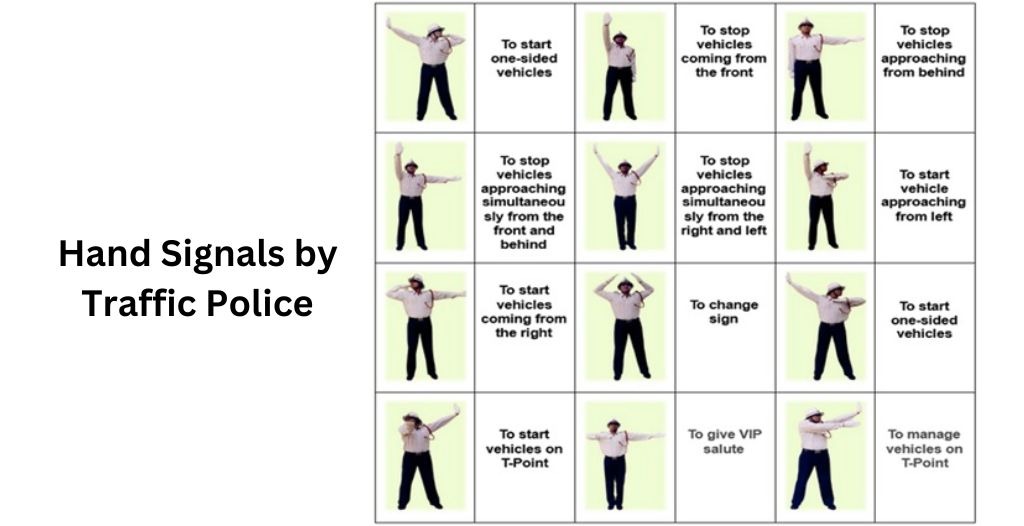
Here are the ten hand signals used by traffic police in India:
1. Stop: The palm faces the oncoming traffic, with the arm outstretched to signal vehicles to stop.
2. Go: The arm is outstretched with the palm facing upwards, signaling vehicles to proceed.
3. Slow Down: The hand moves up and down in a motion that indicates the need for vehicles to reduce their speed.
4. Move to the Left: The right arm is extended and points towards the left, signaling drivers to move to the left lane.
5. Move to the Right: The left arm is extended and points towards the right, signaling drivers to move to the right lane.
6. Straighten Up: The arm moves up and down with the palm facing down, indicating the need for drivers to move their vehicles in a straight line.
7. Turn Left: The left arm is extended out to the side, pointing to the left, indicating that drivers should turn left.
8. Turn Right: The right arm is extended out to the side, pointing to the right, indicating that drivers should turn right.
9. U-Turn: The arm moves up and down in a circular motion, indicating that drivers should make a U-turn.
10. Follow Me: The traffic police officer moves their arm in a circular motion, indicating that drivers should follow them.
These hand signals are crucial for traffic police officers to effectively regulate traffic flow, ensure safety on the roads, and direct drivers, pedestrians, and other road users.
Hand Signals by Drivers
1. Left turn signal: To indicate a left turn, the driver extends their left arm out of the window and points it towards the left side of the road.
2. Right turn signal: When making a right turn, the driver extends their left arm out of the window and bends it at the elbow, with the hand pointing upwards.
3. Stop signal: To signify the intention to stop, the driver extends their left arm out of the window, with the palm facing downwards.
4. Hazard signal: When there is a hazard on the road, the driver extends their left arm out of the window, with the palm facing upwards.
5. Slow down signal: When the driver wants the vehicle behind them to slow down, they extend their left arm out of the window, with the palm facing downwards, and move their arm up and down repeatedly.
6. Overtaking signal: If it is safe for the vehicle behind to overtake, the driver extends their left arm out of the window and makes a circular motion.
7. Thank you signal: To express gratitude, the driver extends their left arm out of the window, with the palm facing upwards.
8. Emergency signal: In the event of an emergency, the driver extends their left arm out of the window, with the palm facing downwards, and moves their arm up and down repeatedly.
9. Police signal: When a police officer is present on the road, the driver extends their left arm out of the window, with the palm facing downwards, and waves it up and down.
10. Horn signal: The driver uses the horn to alert the driver in front of them or to communicate a warning.
These hand signals serve as important means of communication among drivers on the roads in India. They contribute to enhancing safety and promoting efficient traffic flow.
Road Marking or Pavement Marking Signs in India
1. Broken White Lines: These lines are used to separate two lanes of traffic that are moving in the same direction.
2. Solid White Lines: These lines serve as boundaries for driving lanes and should not be crossed by vehicles.
3. Double White Lines: Similar to broken white lines, double white lines are used to separate two lanes of traffic traveling in the same direction. It is important not to cross these lines.
4. Broken Yellow Lines: These lines are used to separate two lanes of traffic that are moving in opposite directions. Vehicles can cross these lines if it is safe to do so.
5. Solid Yellow Lines: Solid yellow lines indicate no passing zones. Vehicles should not cross these lines.
6. Zigzag Lines: Zigzag lines on the road indicate that parking is prohibited in that area.
7. Pedestrian Crossing Markings: These markings are designed to indicate safe locations for pedestrians to cross the road.
8. Centre Lane Markings: Centre lane markings denote a shared turning lane that can be used by vehicles traveling in opposite directions.
9. Arrows: These markings consist of arrows that indicate the direction of traffic flow, helping drivers navigate the roadways.
10. Stop Lines: Stop lines are lines painted on the road that indicate where vehicles should come to a complete stop at intersections or before pedestrian crossings.
Road Rage in India
Road rage is a growing concern in India, with an alarming increase in the number of road rage incidents and cases of reckless driving. According to the Ministry of Road Transport and Highways, the statistics reveal a disturbing trend. In 2019, there were 1,55,000 road rage accidents reported, which escalated to 1,83,000 cases in 2020. Shockingly, the numbers rose even further to 2,15,000 in 2021. Unless immediate action is taken, this worrisome trend will likely continue.
Road rage stems from a multitude of factors, including stress, impatience, and frustration. These emotions can lead to perilous situations for all parties involved, making it imperative to address the issue at its core. Common manifestations of road rage include excessive honking, aggressive driving, tailgating, and offensive gestures.
To combat road rage, drivers must prioritize maintaining calm and patience, while adhering to traffic rules and regulations. It is crucial to abstain from driving while under the influence of drugs or alcohol, as impaired judgment can exacerbate aggressive behavior. Demonstrating consideration for fellow drivers and showing respect on the road are equally vital. It is essential to comprehend that road rage jeopardizes not only the safety of the individual exhibiting such behavior but also that of other drivers, pedestrians, and even animals.
By fostering a culture of responsible driving, promoting awareness about the consequences of road rage, and implementing effective measures, we can collectively mitigate this growing menace. Let us strive towards creating safer roads and nurturing a sense of empathy and understanding among all road users. Remember, it is within our power to make a positive difference and curtail the alarming rise in road rage incidents.
In conclusion, traffic signs play a crucial role in ensuring road safety throughout India. They serve as vital communication tools, conveying important information to drivers, pedestrians, and other road users, thus reducing the likelihood of accidents and fatalities. From stop signs to speed limit signs, from hand signals to road markings, these signs form a visual language that we all must comprehend and adhere to in order to guarantee our safety on the roads.
Much like the harmonious notes of a symphony, traffic signs guide us on our journey, and it is our responsibility to listen and follow their guidance. Disregarding these signs would be akin to attempting to play a song without knowledge of the correct notes—it would simply result in chaos. Let us embrace our roles as responsible road users and actively contribute to creating safer roads for everyone. Together, through our collective efforts, we can make a significant impact, one sign at a time.
Read More:

